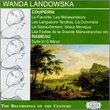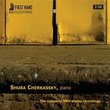| All Artists: Olivier Messiaen, Pierre Boulez, Cleveland Orchestra Title: Messiaen: Et exspecto resurrectionem mortuorum; Chronochromie; La Ville d'en haut Members Wishing: 2 Total Copies: 1 Label: Deutsche Grammophon Release Date: 10/17/1995 Genres: Jazz, Classical Styles: Swing Jazz, Historical Periods, Modern, 20th, & 21st Century Number of Discs: 1 SwapaCD Credits: 1 UPC: 028944582727 |
Search - Olivier Messiaen, Pierre Boulez, Cleveland Orchestra :: Messiaen: Et exspecto resurrectionem mortuorum; Chronochromie; La Ville d'en haut
 | Olivier Messiaen, Pierre Boulez, Cleveland Orchestra Messiaen: Et exspecto resurrectionem mortuorum; Chronochromie; La Ville d'en haut Genres: Jazz, Classical
Pierre Boulez's performances of Olivier Messiaen's scores, especially the tough ones, are legendary, and "Chronochromie" is the composer's most complex and abstract work. Rising to the challenge, Boulez directs what is ... more » ![header=[] body=[This CD is available to be requested as disc only.]](/images/attributes/disc.png?v=15401716) ![header=[] body=[This CD is unavailable to be requested with the disc and back insert at this time.]](/images/attributes/greyed_disc_back.png?v=15401716) ![header=[] body=[This CD is available to be requested with the disc and front insert.]](/images/attributes/disc_front.png?v=15401716) ![header=[] body=[This CD is unavailable to be requested with the disc, front and back inserts at this time.]](/images/attributes/greyed_disc_front_back.png?v=15401716) |
Larger Image |
CD DetailsSynopsis
Amazon.com essential recording Pierre Boulez's performances of Olivier Messiaen's scores, especially the tough ones, are legendary, and "Chronochromie" is the composer's most complex and abstract work. Rising to the challenge, Boulez directs what is clearly its finest recording--not that there's been all that much competition! Of course, he has the great advantage of the Cleveland Orchestra--easily the world's finest ensemble in the field of contemporary music, and a DG recording of extreme clarity. The two couplings are less difficult, but let's not kid ourselves, this isn't a record for the casual listener looking for a pretty tune. It's great music, but it demands commitment. --David Hurwitz Similar CDs
|
CD ReviewsA Balanced and Finely Tuned Performance. S. C Rice | 11/15/2001 (5 out of 5 stars) "When I heard this performance of `Et Expecto Resurrectionem Mortuorum,' my first thought was on how `French' the performance was. It taps into the fascination with timbre that is characteristic of Faure,' of Debussy and of Messiaen. Everything is balanced to a razor sharp perfection. There are no colour smudges here. The voices are given a great amount of equality and reserve to that effect. You can hear everything. The clusters are so balanced that they sound as one voice, which is exactly as they should. There is great attention paid to the gongs being of individual character, so that the separate gongs create a timbral melody that is individual and distinct. Everything is structurally sensitive; dynamics are balanced against all other parts of the piece, timbres are the same when a particular choir enters at one section and when they enter in another. However, the performance is insensitive in other ways. The tempo pushes ahead with the same metronomic drive through most of the piece, bowling over cadences that cry out for a slight slowing. There are changes of tempo, but they are mostly planned so that the timbres can breath enough, for example, to allow us to hear the beats of the chime timbre as it solos. The tam tam crescendi, which I am convinced are there to scare the audience to death with sheer volume, are subdued, put within the context of the larger piece, subordinated. The chilling percussion interludes are also balanced with one another to create one voice, which makes sense within this reading of the piece, but I think that the percussion can be much more macabre, much more frightening if the instruments were to have more freedom of expression (less attention to balance). In effect, the affect is subdued. It comes through, but it feels lacking at certain points in the work. At the final crescendo, one should be absolutely terrified; it should be huge, awful, awesome... but the Cleveland Orchestra doesn't really take it to that point. They technically do crescendo at the end; it gets louder. However, the energy doesn't come up. The ending needs to charge and then leave you hanging. That is one of the whole points of the piece; expectation. I waffle back and forth between this reading and one by the Rundfunk Symphony Orchestra of Berlin under Karl Anton Rickenbacher. They offer a characteristically `German' reading; one that is very expressive and passionate (and that really scares you out of your socks at the end), but in which the voices are not balanced and the work is overall more choppy. I guess when I want to hear the affect of the work, I listen to Rickenbacher. When I want to hear the structure (which is also very meaningful), I listen to Boulez. Both are valuable readings. I recommend both. `Et Expecto Resurrectionem Mortuorum' is one of the best works of Messiaen. It should be heard by anyone with an interest in modern music. It would be an interesting listen for anyone, though, so I recommend it to you." Messiaen's vision, via Boulez and Cleveland R. Hutchinson | a world ruled by fossil fuels and fossil minds | 08/27/2002 (5 out of 5 stars) "Oliver Messiaen was a pivotal, transitional figure in 20th century music, bridging the early Moderns and the post-war serialists. Boulez and Xenakis were both his students. His music is epic, clearly the product of a visionary. This is an essential disc of his work, impeccably performed, conducted and recorded. "Chronochromie," "the color of time," is 7 blocks of music, static and forbidding -- but the orchestra plays an endless variety of bird songs! This was one of Messiaen's central preoccupations, related to the inspiration he received from St. Francis. On first listening, I found it difficult to enter this sound world, but on repeated listening, it opens up vistas of imagination. The echoes of this resolute abstraction can be heard in virtually everything by Xenakis. The middle piece, "The City Above," is a shorter work, and successfully invokes a vision of Heaven. Finally, "I Await the Resurrrection of The Dead" is an unqualified masterpiece. Stirred by his religious faith, Messiaen knocks the listener back in sheer awe with his powers of orchestration. While the Turangalila-symphonie is Messiaen's most popular work, and most often performed, these later works are deeper, greater accomplishments, and should be heard by anyone who has a passion for 20th century music!" Great performances in superlative sound Klingsor Tristan | Suffolk | 08/23/2005 (5 out of 5 stars) "This is a stunning disc - for the performances, for the recorded sound and, of course, for the works themselves.
Chronochromie and Et expecto have both been recorded before - in both cases not long after their premieres. Both are works of Messiaen's Middle Period when the force and impact of Nature as a reflection of the composer's religious beliefs was right in the foreground of his writing (cf. Des canyons aux etoiles, Couleurs de la cite celeste or the Books of the Catalogue d'Oiseaux for other examples). Here you will find Messiaen's passion for birdsong given full rein along with his intensely vivid impressionist musical landscapes. The central movement of Chronochromie where a multitude of solo strings pile up all the different birdsongs of a dawn chorus is magical in this performance - the perfect mix of clarity and chaos. This is staggering writing that, inevitably, foreshadows the passage in St. Francois when the saint preaches to the birds. Chronochromie is the strongest piece on this disc, tightly organised along the lines of classical Greek poetic drama with carefully balanced movements (Strophe set against Antistrophe as in a Greek Chorus) and filled with bold gestures, wonderful melodies and the richest of multihued harmonies (Messiaen always tends to see his harmonies in synesthesic terms). The work has tended to live in the shadow of more obviously dramatic pieces like Canyons and Et expecto. The latter as recorded here will have you jumping at the sudden screeches of the birds. The games with additive rhythms on a range of gongs and tam-tams are certainly exciting. Here, too, are the monumental chorales so typical of Messiaen. But it seems to me that Et expecto lacks some of the cohesion that holds Chronochromie together as a whole work, rather than as a series of pictures. The performances of both works, as well as of La Ville en haut (another vision of the Celestial City) are masterly from the composer's pupil. The clarity of texture, the precision of ensemble and the rhythmical accuracy Boulez secures from his Cleveland forces are all thrilling. The dynamic range will test your equipment and the tolerance of your neighbours, especially in these recordings which present the sounds of the mostly wind and percussion forces with remarkable accuracy and with great depth as well as spread to the stereo image. " |

 Track Listings (13) - Disc #1
Track Listings (13) - Disc #1


